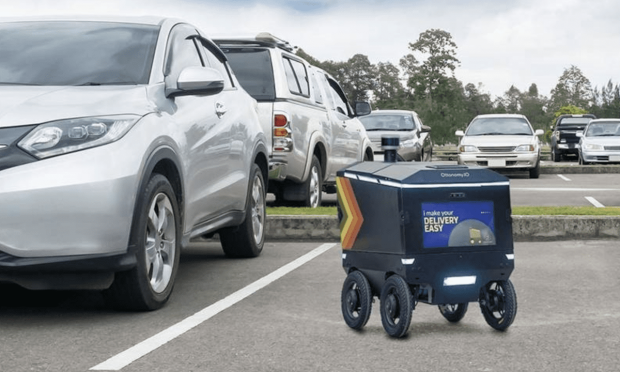Robots Help Restaurants Improve Curbside Delivery

With the challenges of today’s restaurant labor market stretching indefinitely into the future, businesses are looking to automate more stages of the process. While restaurants have been experimenting with autonomous home delivery for years, Redwood City, California-based restaurant technology company Presto, which creates touch, vision and voice solutions, is working on a new use case for delivery robots. On Tuesday (Dec. 7), the company announced a partnership with Santa Monica, California-based autonomous delivery startup Ottonomy to automate curbside delivery.
With the partnership, customers ordering through Presto’s tools will have their orders brought out from the restaurant to the curb or to their parking space by one of Ottonomy’s sidewalk robot-style machines, which run without the aid of human operators.
“The ongoing labor shortage is preventing restaurants from maximizing the revenue potential of digital channels,” Rajat Suri, founder and CEO of Presto, said in a statement. “In partnership with Ottonomy, we can enable restaurants to become more agile in managing staff deployments and associated costs.”
At a time of severe labor challenges, every second counts, and by automating the curbside or carside handoff, restaurants can gain that much time back. Additionally, many of the difficult aspects of autonomous delivery with sidewalk robots —navigating foot and vehicle traffic, and dealing with the slow speeds of these machines — are greatly alleviated when the robots are only tasked with traveling the short distance from the restaurant to the customer’s car.
The curbside channel has gained favor among restaurants in recent years for its relative labor efficiency compared to home delivery, minimizing the distance that a human worker is bringing the customer’s order from a matter of miles to feet. As such, many major brands are turning to the channel as an alternative to home delivery to meet consumers’ need for contactless convenience.
Take, for example, Domino’s. As the pizza chain’s CEO Ritch Allison told analysts on a call in October, “We’re … really pushing on this carside delivery as a service method to try to make things significantly more convenient for customers to pick up product, eliminating the need to go into the store and pay and carry their own food out. We think it’s a significant improvement in the consumer experience, and may tip some more consumers over to come into the carryout channel as opposed to delivery.”
Moreover, the channel has certain benefits for the consumer as well. “When you order for delivery, you’re not sure exactly when it’s going to show up,” he noted. “If it takes just a minute to jump in the car and hop over there, and you know it will come directly to you, so you can keep the kids in the car, it just makes sense.”
In fact, PYMNTS research from the 2021 Restaurant Readiness Index, created in collaboration with Paytronix, finds that 39% of consumers believe curbside pickup will be important to restaurants’ future success, and 46% of managers say the same. Additionally, the Index found that the channel is strongly linked with restaurants’ performance, with top-performing restaurants about four times as likely as bottom performers to offer curbside pickup: 90.7% of the former have the option, compared to just 23.5% of the latter.
Related news: QSRs’ Lagging Loyalty-Reward Investment Hurts Innovation and Sales
For its part, Presto, which has worked with McDonald’s, Applebee’s, Chili’s and Outback Steakhouse, among other major restaurant brands in the United States and abroad, is looking to automate restaurant technology as quickly as possible.
“Some restaurants think of technology and digital as a long-term play with payoff many years from now, and so they slow-roll it,” Suri told PYMNTS in a recent interview. “But actually, I think the companies that really moved quickly on technology and implement it fast are the ones that see the most benefit.”
See also: Drive-Thrus Get a Long-Overdue Tech Upgrade for the 2020s
